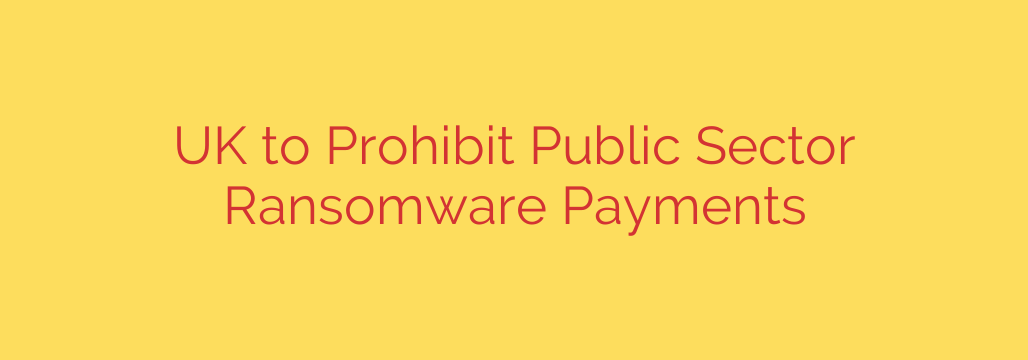
A New Line in the Sand: UK Proposes Ban on Public Sector Ransomware Payments
The digital landscape is a battleground, and ransomware remains one of the most disruptive and costly weapons wielded by cybercriminals. In a landmark move to break the cycle of digital extortion, the UK government is advancing a new policy to prohibit ransomware payments by public sector organizations. This decisive stance aims to cut off the financial lifeline for criminal gangs and hostile state actors who profit from holding critical data and services hostage.
This proposed ban signals a major shift in national cybersecurity strategy. For years, organizations have faced the agonizing choice of paying a ransom to restore services or suffering prolonged downtime and data loss. The new policy effectively removes that choice for public bodies, sending a clear message: the UK will no longer fund cybercrime.
Why a Ban, and Why Now?
The rationale behind this move is straightforward but powerful. Every ransom paid validates and finances the criminal enterprise behind the attack. These payments don’t just solve an immediate problem; they fuel the development of more sophisticated malware, fund recruitment for criminal networks, and encourage further attacks against other vulnerable targets.
Security experts and government officials agree that paying ransoms directly contributes to the proliferation of cybercrime. By making payments illegal for government-funded entities, the UK aims to make its public sector an unprofitable target. The goal is to dismantle the ransomware business model one brick at a time, protecting the nation’s critical infrastructure in the process.
Who Will Be Affected?
The proposed legislation will specifically target what the government terms “critical national infrastructure” (CNI) and other public services. This includes a wide range of essential organizations:
- Local councils and government agencies
- Schools, colleges, and universities
- Healthcare providers, including NHS trusts
- Police forces and emergency services
While the private sector is not included in this specific ban, the move sets a strong precedent. The Information Commissioner’s Office (ICO) already strongly discourages ransom payments for all organizations, warning that payment offers no guarantee of data recovery and does not absolve an entity of its data protection responsibilities.
The Inevitable Shift to Proactive Defense
This policy is not without its challenges. It places immense pressure on public sector leaders who could face catastrophic service disruptions—such as a hospital’s systems going offline—without the option of a quick-fix payment.
However, the core message is undeniable: prevention, not payment, is the only viable long-term strategy against ransomware. The ban is designed to force a fundamental shift from reactive crisis management to proactive cyber resilience. Organizations can no longer view paying a ransom as a last resort; instead, they must invest in building robust defenses that prevent attacks from succeeding in the first place.
Actionable Steps for Cyber Resilience
With the option of payment off the table, robust preparation becomes non-negotiable. Every organization, whether public or private, should prioritize the following security measures to defend against ransomware:
Immutable and Offline Backups: Regularly back up your critical data and systems. Crucially, ensure these backups are kept offline or are immutable (cannot be altered or deleted by an attacker), so they are safe even if your live network is compromised. Test your restoration process frequently.
Implement Multi-Factor Authentication (MFA): One of the most effective single steps you can take is to enable MFA on all accounts, especially for remote access, email, and administrative privileges. This makes it significantly harder for attackers to gain access using stolen credentials.
Vigorous Patch Management: Cybercriminals often exploit known vulnerabilities in software. Maintain a strict process for applying security patches to operating systems, applications, and network devices as soon as they become available.
Develop and Rehearse an Incident Response Plan: What will you do when—not if—an attack occurs? A clear, well-rehearsed plan ensures that everyone knows their role, communication is handled effectively, and steps are taken to isolate the threat and recover systems without causing further damage.
Employee Training and Phishing Simulation: Your staff is your first line of defense. Conduct regular training to help employees recognize and report phishing attempts, which are the most common entry point for ransomware.
By taking a firm stance against ransom payments, the UK government is drawing a clear line. The message is that our public services will not be a source of income for criminals. For organizations, this is a critical call to action to bolster their defenses, invest in resilience, and prepare for a future where paying the ransom is no longer an option.
Source: https://www.bleepingcomputer.com/news/security/uk-to-ban-public-sector-orgs-from-paying-ransomware-gangs/








